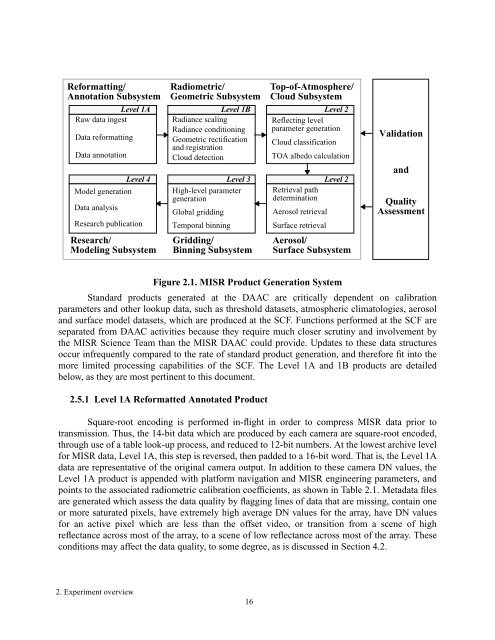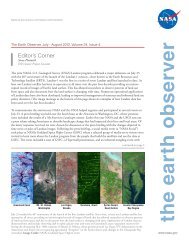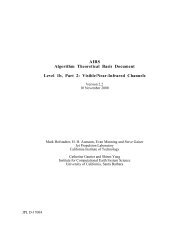MISR: In-Flight Radiometric Calibration and Characterization Plan
MISR: In-Flight Radiometric Calibration and Characterization Plan
MISR: In-Flight Radiometric Calibration and Characterization Plan
Create successful ePaper yourself
Turn your PDF publications into a flip-book with our unique Google optimized e-Paper software.
Reformatting/Annotation Subsystem<strong>Radiometric</strong>/Geometric SubsystemTop-of-Atmosphere/Cloud SubsystemLevel 1A Level 1B Level 2Raw data ingestRadiance scalingRadiance conditioningReflecting levelparameter generationData reformatting Geometric rectification Cloud classification<strong>and</strong> registrationData annotationCloud detectionTOA albedo calculationLevel 4Model generationData analysisResearch publicationResearch/Modeling SubsystemLevel 3High-level parametergenerationGlobal griddingTemporal binningGridding/Binning SubsystemLevel 2Retrieval pathdeterminationAerosol retrievalSurface retrievalAerosol/Surface SubsystemValidation<strong>and</strong>QualityAssessmentFigure 2.1. <strong>MISR</strong> Product Generation SystemSt<strong>and</strong>ard products generated at the DAAC are critically dependent on calibrationparameters <strong>and</strong> other lookup data, such as threshold datasets, atmospheric climatologies, aerosol<strong>and</strong> surface model datasets, which are produced at the SCF. Functions performed at the SCF areseparated from DAAC activities because they require much closer scrutiny <strong>and</strong> involvement bythe <strong>MISR</strong> Science Team than the <strong>MISR</strong> DAAC could provide. Updates to these data structuresoccur infrequently compared to the rate of st<strong>and</strong>ard product generation, <strong>and</strong> therefore fit into themore limited processing capabilities of the SCF. The Level 1A <strong>and</strong> 1B products are detailedbelow, as they are most pertinent to this document.2.5.1 Level 1A Reformatted Annotated ProductSquare-root encoding is performed in-flight in order to compress <strong>MISR</strong> data prior totransmission. Thus, the 14-bit data which are produced by each camera are square-root encoded,through use of a table look-up process, <strong>and</strong> reduced to 12-bit numbers. At the lowest archive levelfor <strong>MISR</strong> data, Level 1A, this step is reversed, then padded to a 16-bit word. That is, the Level 1Adata are representative of the original camera output. <strong>In</strong> addition to these camera DN values, theLevel 1A product is appended with platform navigation <strong>and</strong> <strong>MISR</strong> engineering parameters, <strong>and</strong>points to the associated radiometric calibration coefficients, as shown in Table 2.1. Metadata filesare generated which assess the data quality by flagging lines of data that are missing, contain oneor more saturated pixels, have extremely high average DN values for the array, have DN valuesfor an active pixel which are less than the offset video, or transition from a scene of highreflectance across most of the array, to a scene of low reflectance across most of the array. Theseconditions may affect the data quality, to some degree, as is discussed in Section 4.2.2. Experiment overview16







